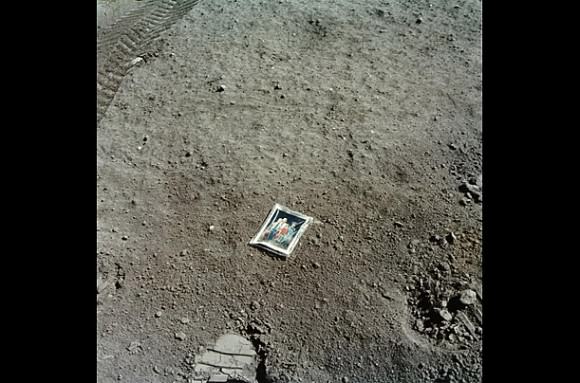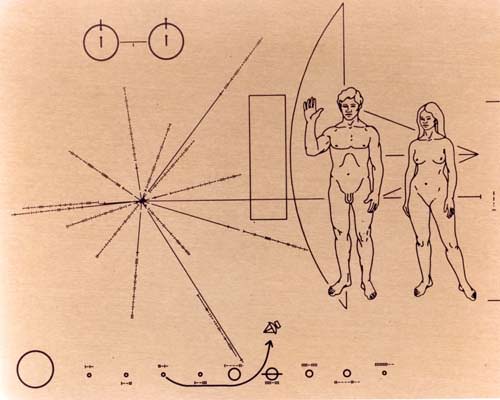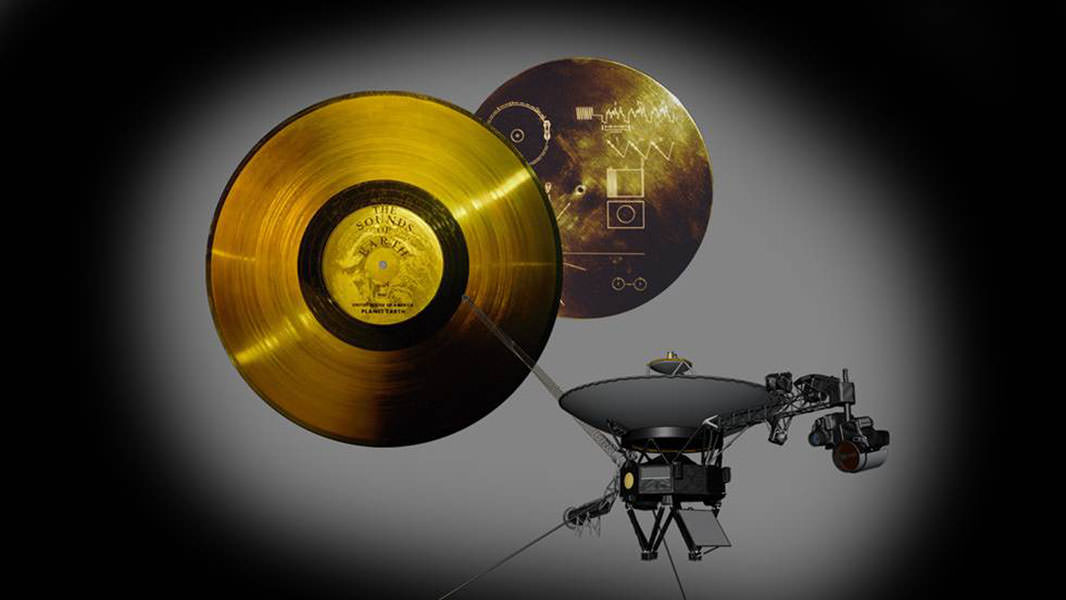[/caption]
Greeting cards in space… We’ve certainly sent our share of them, haven’t we? So if humankind is foresighted enough to leave messages of our whereabouts – and our personalities – in space, then why haven’t other alien civilizations done the same? That’s a question a pair of postdoctoral researchers at Penn State are asking. By using mathematical equations, they’re showing us we simply haven’t looked in enough places… and would we recognize an alien artifact even if it were staring us in the face?
“The vastness of space, combined with our limited searches to date, implies that any remote unpiloted exploratory probes of extraterrestrial origin would likely remain unnoticed,” report Jacob Haqq-Misra, Rock Ethics Institute, and Ravi Kumar Kopparapu, Earth and Environmental Systems Institute, in a paper accepted by Acta Astronautica and posted online on ArXiv.
So far, we simply haven’t found any evidence of alien artifacts in our solar system – or anywhere else for that matter. According to the Penn State article, the Fermi paradox, originally formulated by Enrico Fermi, asks, if intelligent life is common, why have no technological civilizations been observed. Well, shucks… Maybe they’re shy – and maybe they’ve self-annihilated. There are hundreds of reasons “why” we haven’t found anything, but the most pertinent answer is we simply aren’t looking for the right thing in the right place at the right time. For example, have a look at just a few of the things we humans have sent into vastness of space to act as our ambassadors…



And this is only just the tip of the human iceberg. How many of us have sent our name on missions to Mars, Pluto and more? There are footprints, plaques, flags, golf balls and an endless parade of human artifacts scattered far and wide. We might think they’re in plain sight, but would an alien culture see that? Would we comprehend what an alien culture might consider to be a greeting or sign or their presence? As far as we know, there could be unpiloted probes from alien civilizations out there right now, checking us out… But unless it were something the size of a proverbial school bus dropping itself on a house in Essex, our own arrogance would probably keep us from noticing it. And then again… it just might be hidden.
“Extraterrestrial artifacts may exist in the Solar System without our knowledge simply because we have not yet searched sufficiently,” said Haqq-Misra and Kopparapu. “Few if any of the attempts would be capable of detecting a 1 to 10 meter (3 to 33 foot) probe.”
Haqq-Misra and Kopparapu use a probabilistic method to determine the feasibility of aliens leaving us clues to their existence. Their work points to the Solar System as a fixed volume and then calculates the percentages of that volume that would need to be thoroughly searched to detect an alien probe or artifact. These searches would have to involve technology able to detect small, foreign objects and then apply it to a smaller portion of the volume to look for results. It’s a study which hasn’t been undertaken so far. We simply cannot say we’ve looked everywhere…
“The surface of the Earth is one of the few places in the Solar System that has been almost completely examined at a spatial resolution of less than 3 feet,” said Haqq-Misra and Kopparapu.
Sure. There are still a lot of nooks and crannies on Earth that haven’t been thoroughly explored – and our oceans are a good example. However, when it comes to searching elsewhere, it’s been a hit-or-miss proposition. While mapping the surface of the Moon, the Lunar Reconnaissance Orbiter is looking at the surface at a resolution of about 20 inches. It may take a few years, but perhaps something isn’t buried under the regolith. As for Mars, chances are slight – but new things seem to be discovered on Mars each day, don’t they? How about the LaGrange points, or the asteroid belt? Things could be hiding there, too.
“Searches to date of the Solar System are sufficiently incomplete that we cannot rule out the possibility that non terrestrial artifacts are present and may even be observing us,” said Haqq-Misra and Kopparapu. They add that “the completeness of our search for non terrestrial objects will inevitably increase as we continue to explore the Moon, Mars and other nearby regions of space.”
After all, what did we expect? E.T. to interrupt a prime time television program to announce their presence? A take-over of the Internet? Maybe each time a meteor makes it to Earth it’s a little calling card that life-possible organisms exists outside our own little sphere…
And maybe somebody needs to drop a bus on us.
Original Story Source: Penn State News Release.


Oh boy. The comments for this post are going to be…interesting.
You guys… They already answered us…!! It’s just not mainstream yet…. the walls of our small reality are breaking up and there is SO much to discover.
http://www.cropcircleresearch.com/articles/arecibo.html
haha, crop circles!
Why would a super-advanced ET travel light-years across interstellar distances, only to leave a message by knocking down rows of corn?
It’s patently absurd, and undoubtedly every prankster that’s ever participated in making a crop circle gets a laugh when he sees credulous posts from believers.
Often, form does follow function. If not too damaged, functional items may therefore be recognized as created rather than natural.
As for non-functional items, though, they could easily be waved away as coincidental natural formations, especially if damaged. (How long did it take humans to accept that fossils were the remains of once-living creatures?)
I am not sure I follow. Do you say that organisms are non-functional? So called traits is another word for function, at least if they are adaptively fixed. For example, eye function.
Function is not a qualitative divide between the natural world and cultural artifacts. (Which, if you think about it, are also part of the natural world.) Those who make that distinction against facts is usually creationists.
Yeah, sorry about that. I talked about the difference between made things with an obvious function (such as a radio dish) and made things with a function which may not be obvious (such as audio discs) then used as an example once living things.
Well.. The Asgard have been hovering above our atmosphere in huge ships for centuries and even with our best radars we havent detected them yet.
The Voyager spacecrafts are the ultimate case of a message in a bottle. We need to consider the material proportions of things. The sun has about 10^{33}kg of mass. The Voyager spacecraft has about 10^3 Kg of mass. This spacecraft is now drifting around in a galaxy with 10^{11} stars. This means about one part in 10^{43} of this galaxy comprises the Voyager spacecraft. Both of these spacecrafts will drift around in space for hundreds of millions of years. They may over this time come close to a star system comparable to ours. There is some tiny probability they may pass a star system with intelligent life, and if it does it will likely pass by unnoticed, just as if such a craft passed through our solar system it is very unlikely we would detect it. I doubt there are a hundred billion bottles waiting to be washed up on various interplanetary shores.
LC
[sarcasm]
According to homeopathy, that means the whole galaxy should feel its effect!
[/sarcasm]
Also, how did I guess that link of yours was to The Police song “Message in a Bottle”, before even clicking on it?
The comparison with homeopathy is interesting. BTW, I know a couple of people who swear by it, even though it is patent nonsense. Yet seriously, if we sent out interestellar probes, say 100 of then, then they can only cover this epsilon bit of the entire galaxy. Setting up a monolith on an airless moon or planet in a stellar system with a bio-active planet is a gamble. The planet might not produce intelligent life, and if it does 100 million years later micrometeoroid impacts will have degraded any message on it.
LC
If you will recall, in the film 2001: A Space Odyssey, the black monolith, dubbed “Tycho Magnetic Anomaly One” (TMA-1), was “deliberately buried” and was only discovered because of its intense magnetic field, which was the intention of the aliens who buried it.
This is like the Drake equation – punch in a bunch of variables that you have no way of knowing the value of, so just guesstimate without any real basis for those guesstimations and come up with the most inaccurate number imaginable. It’s not real science.
Lets not get ahead of ourselves by trying to predict the feasibility of detecting something that may not exist (i.e. alien civilizations). We don’t even have any proof that life exists on other planets and we don’t even know if life can evolve into forms that are more complex and more intelligent than humans. Lets focus on finding a planet with life on it before we go spending the time, energy and money looking for physical alien artifacts. We’re making some great progress on finding exoplanets and that is where I think our energy should be focused.
Well, bear in mind that the Drake Equation isn’t intended to provide anything approaching an accurate value for the number of civilizations in the galaxy; the whole point of it was to show that, even setting all of the variables to very small values the sheer number of systems present in the galaxy could still produce a relatively large number of such civilizations.
I would maintain that there is a world of difference between the Fermi paradox and the Drake equation.* The Drake equation is a predictive model, where all factors can be potentially constrained. For example, Kepler goes a long way to pin down some of these factors.
Yes, we already know the answer to that one: it ain’t gonna happen.
One of my largest beefs with my astrobiology course was where they take a diagram of the genome and extrapolate a rising trend in complexity by using Kurzweil type cherry-picking of data. This isn’t what biologists teach.
Yes, if you start out with one gene family the genome will eventually expand. But already the LUCA was likely as complex as modern bacteria, and that has been more or less well validated.
Then you take a step in complexity because eukaryotes happened to integrate a mitochondrion endosymbiont once, rather early. According to Lane’s energy hypothesis, also rather well validated, it is the mitochondrion power plant that gives eukaryotes ~ 10^5 more energy for protein turnaround. (Bacteria have to copy their entire genome to get another metabolic core: no gain. Eukaryotes can copy the “parasitically” slimmed mitochondrion genome: a large factor gain.)
That protein turnaround enables expanding and supporting a larger genome. And in our case multiple levels of gene and other type of regulation. However again you reach an early plateau, where for example some single cell amoebas have much larger genomes than our cells ever can have.
So there is no medieval religious based “ladder of progress” to be found in biology. Evolution can simplify as often as it complexify. It is better to think of it as a random walk in a functional phase space, where it started out simple but today there is little change.**
And even if not, eventually you reach the protein turnaround energy limit.
A similar problem happens for neural systems, and some biologists claim that animals can at best support about twice as much neuron to other cells. (Living like flies on more or less pure sugar, at that.) For example, for our size that is a ~ 3.5 kg brain (IIRC) max.
Now you can do a Kurzweil, but then it isn’t biological evolution.
——————
* The Drake equation can be used to deliver one answer to the Fermi paradox. Unfortunately, so can many, too many, other predictive models.
** Of course when humans started to complexify its own culture, we sped up evolution. But I don’t think you can say that we are more complex now. More intelligent, yes.
Either Mars or the Moon would be a great place for ancient aliens to leave artifacts if their intent was to notify us of their existence. Both would require the rise of space-faring technology before we could find them, thus simultaneously increasing our chances of recognizing what they represent while eliminating any possibility of them being destroyed by geologic processes on the planet.
It’s a longshot so we shouldn’t invest money into looking for them, but it doesn’t hurt to keep our eyes open while we are mapping these worlds in detail.
Ask Eric Cartman.
If you have a message, you will want it to back itself up periodically. If you land on the Cambrian earth, you might take an ordinary bilateral echinoderm, and encode your message into its genes, and to make really sure the message gets noticed, you make sure that the same bit of coding gives the creature something outlandish like five-fold rotational symmetry in the adult phase because that just doesn’t happen in nature.
Starfish. Star-fish. Obvious really, just look at the things…
Or have primitive humans genetically altered…
We should have sent another Voyager probe strait to Alpha Centauri.
We should have sent another Voyager probe strait to Alpha Centauri.
Even if there’s anyone there capable of detecting and intercepting it (or if there will be, by that time), you’d have to be *seriously* patient. It would take about 77,000 years to get there…
This is why I find the Fermi paradox too unconstrained: “There are hundreds of reasons “why” we haven’t found anything”. Hence it is a badly formulated problem.
But the article points out an example for that even such problems can at times be used to derive useful information.
Trying to find a CD ( or a 6×9 plaque) floating around in the universe makes the proverbial “needle in a haystack” seem like trying to find the elephant in the living room.
Consider also that there are things that have been hidden here on Earth for about 3 or 4 thousand years: King Tut’s Tomb, for one. And other things we haven’t found yet.
Or the dot of microfilm hidden behind one of the lights in Vegas.
Someone on Coast to Coast (can’t remember who) made this good point: There is probably not a single cow on Earth that knows that we eat cows. I’m not suggesting that humans are anyone’s lunch, but If there is an alien presence in our midst, or even watching us, would we even recognize it? And what if this presence didn’t go out of its way to broadcast its presence to us?
Really, there are plenty of people who make claims that they have met aliens, filmed them, been implanted by them, etc., and the scientists and government representatives whose “yeahs” or “nays” make knowledge official don’t exactly follow up on these claims with open minds… if at all. For instance, there is a LOT of NASA footage of strange things flying past the ISS or skimming the atmosphere, and that agency has little to say about them. A couple of times they have taken individual examples and said that they were probably images of ice particles or something ho-hum like that, but they don’t seem very committed to these explanations or to analyzing the whole collection of pics and coming up with well-reasoned theories as to what they show.
On the rare occasion that officials do come forward with stories of the otherworldly, as in the Washington press club disclosure events where military personnel and commercial pilots came forward to tell their stories in a frank and believable manner, and at considerable risk to their reputations – the newspapers, major TV news outlets and other media the people trust to tell them about the world don’t discuss it. (Here in Ottawa, it was reported as a tiny snippet in the corner of one of the inner pages of a local newspaper.)
In the absence of official discussion on the topic, and in the presence of obvious hoaxes and active imaginations, we really have to make up our own minds. Do we think the evidence is sufficient to suggest that there are aliens visiting Earth? I do. But that’s just me. And no, I don’t wear a tinfoil hat.
“There is probably not a single cow on Earth that knows that we eat cows.”
I love this quote. I suspect that cows do not have enough information and enough intelligence to process it. I do not reject the possibility that there may be higher forms of intelligence than us, but I suspect that intelligence, like mathematics, will be substantially common to all creatures that possess it. Some intelligences may have blind spots: a single intelligent life form that covers an entire planet may have trouble understanding and relating to the creatures that land upon it because it has never met the idea of intelligence outside itself. But the general process of understanding is the same.
Here’s my story. I had to go the US for my job, many years ago. I kept my passport in the top drawer in my bedroom. A day or so before I went, I opened the drawer, and it wasn’t there. I had an old passport, so I knew the exact size, and I found a roll of tape that it could just not fit through. I then passed everything in the chest of drawers through this tape roll, so the passport could not be hiding in anything. The chest of drawers was a small kit one, so I could then take it apart. No passport. Weird, because I was certain it was in the top drawer. So, a motorbike rider was sent to the UK passport office then to the US embassy, and with considerable embarassment, I went off to the US, and came back. I opened the drawer to put away the passport, and with a ‘plop’ the other passport suddenly dropped (but from where?) onto the top of the contents in the drawer.
No, I have no explanation. I doubt I ever will. It didn’t make me believe in the supernatural or the paranormal. There is probably something wrong in my observations or recollections. However, if there were enough people like Carl Jung, the psychologist and major loon, who believed his books and other items popped in and out of existence; then people might collect and document stories like this, and the resulting corpus would look impressive.
Naah. A small amount of inexplicable weird stuff just happens. And it almost never happens when you have a camera.
Little blue men come in at night and move things around. I know they’re blue ’cause my cats caught one. :-^)
The question I’d like to know is, how long will that disc actually last before it becomes unreadable as we know it. I’ve read that it’ll take some 25,000yrs(?) to get to the closest star. Surely no man made object will last that long even in a vacuum.
The disc is expected to last hundreds of millions of years. There’s very little out there to degrade it.
Novae, supernovae, gas, dust, rays, …?
None of those are common enough or widespread enough to affect the insterstellar probes on their current trajectories. The probes certainly won’t be going near any novae any time in the next few hundred million years.
… but gas, dust, and rays are common and widespread enough. Each and every particle moving nearly with the speed of light will laugh at you. The “next few hundred million years” is a really long time, and it’s enough time for any particle from any nova or supernova in our galaxy to come here and hit out poor probes. As far as I’m concerned, I think, “the disk” will be destroyed completely after such a long time.
The calculations have already been done. The team who engineered the probes calculated how long they’d last.
You have to be more specific!
Is that a single or double decked bus?
A school bus is fine!
It shows an eagerness and willingness to learn where to look eh!
I propose that the next NASA mission to the Moon should secretly bury a monolith at the next landing site where the Chinese will land. Just to have some fun if they discover it.